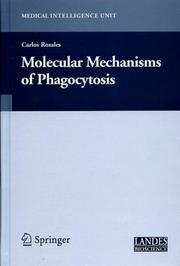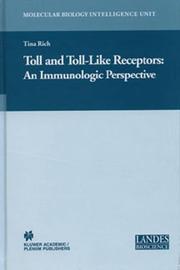| Listing 1 - 10 of 10 |
Sort by
|
Book
ISBN: 148993748X Year: 1988 Publisher: New York : Springer Science+Business Media, LLC,
Abstract | Keywords | Export | Availability | Bookmark
 Loading...
Loading...Choose an application
- Reference Manager
- EndNote
- RefWorks (Direct export to RefWorks)
Reticulo-endothelial system. --- Hematopoietic system --- Mesenchyme --- Phagocytosis

ISBN: 1280626046 9786610626045 3798516103 379851609X 3798599998 Year: 2006 Publisher: Heidelberg : Steinkopff : Imprint: Steinkopff,
Abstract | Keywords | Export | Availability | Bookmark
 Loading...
Loading...Choose an application
- Reference Manager
- EndNote
- RefWorks (Direct export to RefWorks)
This book describes unusual cases of cutaneous lymphomas and is of special interest for clinicians and pathologists dealing with the vexing subject of cutaneous lymphoma. In addition to the case description, it gives the clinical, histological, and in most cases also the phenotypical features and the results of molecular techniques. A commentary puts the observations into the context of cutaneous lymphomas. Related papers are cited. The book will be especially helpful in cases which do not fit into the normal spectrum of cutaneous lymphomas. Rare entities of cutaneous lymphomas are demonstrated with high-quality pictures (4-color) and a concise text in an appealing format throughout the book. The new WHO/EORTC-Classification of Cutaneous lymphomas includes more than 30 entities of Cutaneous T-cell and Cutaneous B-cell lymphomas.
Lymphomas. --- Skin --- Tumors. --- Germinoblastomas --- Immunoblastomas --- Lymphoma --- Non-Hodgkin's lymphoma --- Reticulolymphosarcomas --- Sarcoma, Germinoblastic --- Sarcoma, Immunoblastic --- Lymphoproliferative disorders --- Reticulo-endothelial system --- Tumors --- Dermatology. --- Oncology . --- Oncology. --- Medicine --- Diseases

ISBN: 1281309842 9786611309848 0387286691 1423724070 0387254196 1489997636 Year: 2005 Publisher: New York, NY : Springer US : Imprint: Springer,
Abstract | Keywords | Export | Availability | Bookmark
 Loading...
Loading...Choose an application
- Reference Manager
- EndNote
- RefWorks (Direct export to RefWorks)
Although, Phagocytosis was first described nearly 120 year ago, we are just recently beginning to understand the molecules that phagocytic cells use to bring about this complex cell function. Molecular Mechanisms of Phagocytosis was prepared as a series of up-to-date essays (chapters) that describe the present knowledge on the various steps of the phagocytic process from initial cell contact, through internalization of the foreign particle, to the final phagosome formation where the phagocytosed particle is destroyed.
Phagocytosis. --- Antigen-antibody reactions --- Endocytosis --- Immune response --- Immunology --- Phagosomes --- Pinocytosis --- Reticulo-endothelial system --- Tuftsin --- Cytology. --- Oncology. --- Immunology. --- Biochemistry. --- Microbiology. --- Cell Biology. --- Cancer Research. --- Biochemistry, general. --- Microbial biology --- Biology --- Microorganisms --- Biological chemistry --- Chemical composition of organisms --- Organisms --- Physiological chemistry --- Chemistry --- Medical sciences --- Immunobiology --- Life sciences --- Serology --- Tumors --- Cell biology --- Cellular biology --- Cells --- Cytologists --- Composition --- Cell biology. --- Cancer research. --- Cancer research
Periodical
ISSN: 23314486 Year: 2000 Publisher: [Dallas, Tex.] : [Cancer Information Group],
Abstract | Keywords | Export | Availability | Bookmark
 Loading...
Loading...Choose an application
- Reference Manager
- EndNote
- RefWorks (Direct export to RefWorks)
Lymphomas --- Lymphoma. --- Lymphomas. --- Germinoblastomas --- Immunoblastomas --- Lymphoma --- Non-Hodgkin's lymphoma --- Reticulolymphosarcomas --- Sarcoma, Germinoblastic --- Sarcoma, Immunoblastic --- Germinoblastoma --- Lymphoma, Malignant --- Reticulolymphosarcoma --- Germinoblastic Sarcoma --- Germinoblastic Sarcomas --- Lymphomas, Malignant --- Malignant Lymphoma --- Malignant Lymphomas --- Sarcomas, Germinoblastic --- Lymphoproliferative disorders --- Reticulo-endothelial system --- Lymphatic Diseases --- Hematologic Neoplasms --- Tumors
Periodical
Abstract | Keywords | Export | Availability | Bookmark
 Loading...
Loading...Choose an application
- Reference Manager
- EndNote
- RefWorks (Direct export to RefWorks)
Lymphomas --- Lymphoma. --- Lymphomas. --- Germinoblastomas --- Immunoblastomas --- Lymphoma --- Non-Hodgkin's lymphoma --- Reticulolymphosarcomas --- Sarcoma, Germinoblastic --- Sarcoma, Immunoblastic --- Germinoblastoma --- Lymphoma, Malignant --- Reticulolymphosarcoma --- Germinoblastic Sarcoma --- Germinoblastic Sarcomas --- Lymphomas, Malignant --- Malignant Lymphoma --- Malignant Lymphomas --- Sarcomas, Germinoblastic --- Lymphoproliferative disorders --- Reticulo-endothelial system --- Lymphatic Diseases --- Hematologic Neoplasms --- Tumors --- Oncology

ISBN: 1280804246 9786610804245 0387274456 0306482371 1441934383 Year: 2005 Publisher: New York, NY : Springer US : Imprint: Springer,
Abstract | Keywords | Export | Availability | Bookmark
 Loading...
Loading...Choose an application
- Reference Manager
- EndNote
- RefWorks (Direct export to RefWorks)
Toll Receptors and the Renaissance of Innate Immunity Elizabeth H. Bassett and Tina Rich Overview n the last few pages of Immunology: The Science of Self-Nonself Discrimination Jan Klein ponders on what he would study if he were to start over in the lab. ^ Dismissing the I antibody, MHC, the T-cell and parasitology, he considers instead the phylogeny of immune reactions, particularly in ancient phyla. As for a favored cell he chooses the macrophage. Describ ing it as a ^^MddchenfUr alles," (all purpose kitchen maid) Klein believed that this immunocyte still had secrets to reveal. Toll-Like Receptor (TLR) biology would prove to be one of these secrets. Analyses of the evolution of these receptors (Tolls and TLRs) have also helped us to rethink immune system phylogeny. In the first part of this chapter the history of the discovery of Toll and TLR biology is described. The evolution of the TLR genes and theories of immune function are covered in later sections. The remainder of this book presents work from nine groups active in the field. In the first chapter, "The Function of Toll-Like Receptors", Zlatko Dembic sets the stage by introducing us to many of the components of the immune system and their relationships vis a vis Toll receptors. Zlatko finishes his chapter with a discussion about current immune system models and contributes his own 'integrity model'. Work from the laboratory of Nicholas Gay follows this in "Structures and Motifs Involved in Toll Signaling".
B cells --- Macrophages --- Dendritic cells --- Natural immunity. --- Cellular immunity. --- Receptors. --- Cell-mediated immunity --- Cellular immunology --- Clonal selection theory --- Immune response --- Immunity --- Disease resistance --- Host resistance --- Innate immunity --- Innate resistance --- Native immunity --- Natural resistance --- Nonspecific immunity --- Resistance to disease --- Follicular dendritic cells --- Interdigitating cells --- Antigen presenting cells --- Lymphoid tissue --- Histiocytes --- Mononuclear phagocytes --- Connective tissue cells --- Killer cells --- Phagocytes --- Reticulo-endothelial system --- B lymphocytes --- Bone marrow derived cells --- Bursa equivalent cells --- Lymphocytes --- Cytology. --- Immunology. --- Cell Biology. --- Immunobiology --- Life sciences --- Serology --- Cell biology --- Cellular biology --- Biology --- Cells --- Cytologists --- Cell biology.
Periodical
ISSN: 19380712 Year: 2005 Publisher: [Dallas, TX] : [CIG Media Group],
Abstract | Keywords | Export | Availability | Bookmark
 Loading...
Loading...Choose an application
- Reference Manager
- EndNote
- RefWorks (Direct export to RefWorks)
Lymphomas --- Multiple myeloma --- Lymphoma. --- Multiple Myeloma. --- Lymphomas. --- Multiple myeloma. --- Kahler's disease --- Plasma cell myeloma --- Germinoblastomas --- Immunoblastomas --- Lymphoma --- Non-Hodgkin's lymphoma --- Reticulolymphosarcomas --- Sarcoma, Germinoblastic --- Sarcoma, Immunoblastic --- Kahler Disease --- Myeloma, Multiple --- Myeloma-Multiple --- Myelomatosis --- Plasma Cell Myeloma --- Myeloma, Plasma-Cell --- Cell Myeloma, Plasma --- Cell Myelomas, Plasma --- Disease, Kahler --- Multiple Myelomas --- Myeloma Multiple --- Myeloma, Plasma Cell --- Myeloma-Multiples --- Myelomas, Multiple --- Myelomas, Plasma Cell --- Myelomas, Plasma-Cell --- Myelomatoses --- Plasma Cell Myelomas --- Plasma-Cell Myeloma --- Plasma-Cell Myelomas --- Germinoblastoma --- Lymphoma, Malignant --- Reticulolymphosarcoma --- Germinoblastic Sarcoma --- Germinoblastic Sarcomas --- Lymphomas, Malignant --- Malignant Lymphoma --- Malignant Lymphomas --- Sarcomas, Germinoblastic --- Multiple Myeloma --- Myeloma Proteins --- Lymphatic Diseases --- Hematologic Neoplasms --- B cells --- Monoclonal gammopathies --- Plasmacytoma --- Lymphoproliferative disorders --- Reticulo-endothelial system --- Tumors
Periodical
ISSN: 21522669 21522650 Year: 2010 Publisher: Dallas, TX : New York, NY : CIG Media Group, Elsevier
Abstract | Keywords | Export | Availability | Bookmark
 Loading...
Loading...Choose an application
- Reference Manager
- EndNote
- RefWorks (Direct export to RefWorks)
Lymphomas --- Leukemia --- Leukemia. --- Lymphomas. --- Lymphoma --- Multiple Myeloma --- Kahler Disease --- Myeloma, Multiple --- Myeloma-Multiple --- Myelomatosis --- Plasma Cell Myeloma --- Myeloma, Plasma-Cell --- Cell Myeloma, Plasma --- Cell Myelomas, Plasma --- Disease, Kahler --- Multiple Myelomas --- Myeloma Multiple --- Myeloma, Plasma Cell --- Myeloma-Multiples --- Myelomas, Multiple --- Myelomas, Plasma Cell --- Myelomas, Plasma-Cell --- Myelomatoses --- Plasma Cell Myelomas --- Plasma-Cell Myeloma --- Plasma-Cell Myelomas --- Germinoblastoma --- Lymphoma, Malignant --- Reticulolymphosarcoma --- Sarcoma, Germinoblastic --- Germinoblastic Sarcoma --- Germinoblastic Sarcomas --- Germinoblastomas --- Lymphomas, Malignant --- Malignant Lymphoma --- Malignant Lymphomas --- Reticulolymphosarcomas --- Sarcomas, Germinoblastic --- Immunoblastomas --- Non-Hodgkin's lymphoma --- Sarcoma, Immunoblastic --- Leucaemia --- Leucemia --- Leucocythaemia --- Leucocythemia --- Leucosis --- Leukaemia --- Leukosis --- Myeloma Proteins --- Lymphatic Diseases --- Hematologic Neoplasms --- Lymphoproliferative disorders --- Reticulo-endothelial system --- Anemia --- Cancer --- Leucocytosis --- Preleukemia --- Tumors --- Health Sciences --- Oncology --- leukemie --- Lymphoma. --- Multiple Myeloma.
Book
ISBN: 9401782997 140209292X 9786612037993 1282037994 1402092938 Year: 2009 Publisher: Dordrecht : Springer Netherlands : Imprint: Springer,
Abstract | Keywords | Export | Availability | Bookmark
 Loading...
Loading...Choose an application
- Reference Manager
- EndNote
- RefWorks (Direct export to RefWorks)
Phagocytosis has been at the forefront of cell biology for more than a century. Initially, phagocytosis, which comes from Greek words meaning “devouring cells,” was discovered in the late 19th century by Ilya Metchnikoff, who was awarded, together with Paul Ehrlich, the Nobel Prize in Physiology and Medicine in 1908 “in recognition of their work on immunity.” At that time Metchnikoff had already identified a function for phagocytes not only in host defense but also as scavengers of degenerating host cells during metamorphosis of tadpoles, thus providing one of the first descriptions of apoptotic cell clearance by macrophages (Kaufmann 2008). Since then, much has been learned about phagocytosis, and the previous several decades have witnessed outstanding progress in understanding the functions and the molecular mechanisms of phagocytosis. Two main types of targets are cleared by phagocytosis: microbial pathogens and dying cells. Rapid recognition and clearance of dying cells by phagocytes plays a pivotal role in development, maintenance of tissue homeostasis, control of immune responses, and resolution of inflammation. Clearance of dying cells can be divided into several stages, including sensing, r- ognition, binding and signaling, internalization, and immunological responses. In this book, our contributors address these different stages of dead cell cle- ance and examine how impaired clearance of dying cells may lead to human d- eases. We have attempted to provide sufficient cross-referencing and indexing to enable the reader to easily locate the ideas elaborated in the different chapters.
Cytology. --- Immunology. --- Medicine. --- Oncology. --- Rheumatology. --- Phagocytosis --- Cell death --- Disease --- Physiology --- Cell Death --- Cell Physiological Processes --- Immune System Processes --- Endocytosis --- Biological Science Disciplines --- Blood Physiological Processes --- Immunity, Innate --- Pathologic Processes --- Immunity --- Natural Science Disciplines --- Immune System Phenomena --- Blood Physiological Phenomena --- Pathological Conditions, Signs and Symptoms --- Cell Physiological Phenomena --- Circulatory and Respiratory Physiological Phenomena --- Disciplines and Occupations --- Phenomena and Processes --- Diseases --- Microbiology & Immunology --- Biology --- Health & Biological Sciences --- Phagocytosis. --- Cell death. --- Cell degeneration --- Cancer research. --- Apoptosis. --- Biomedicine. --- Cancer Research. --- Cells --- Death (Biology) --- Antigen-antibody reactions --- Immune response --- Immunology --- Phagosomes --- Pinocytosis --- Reticulo-endothelial system --- Tuftsin --- Oncology . --- Internal medicine --- Connective tissues --- Joints --- Immunobiology --- Life sciences --- Serology --- Cell biology --- Cellular biology --- Cytologists --- Tumors --- Cancer research
Book
ISBN: 3642260373 364200301X 9786612509223 1282509225 3642003028 Year: 2009 Publisher: Berlin, Heidelberg : Springer Berlin Heidelberg : Imprint: Springer,
Abstract | Keywords | Export | Availability | Bookmark
 Loading...
Loading...Choose an application
- Reference Manager
- EndNote
- RefWorks (Direct export to RefWorks)
Autophagy is a fundamental biological process that enables cells to autodigest their own cytosol during starvation and other forms of stress. It has a growing spectrum of acknowledged roles in immunity, aging, development, neurodegeneration, and cancer biology. An immunological role of autophagy was first recognized with the discovery of autophagy’s ability to sanitize the cellular interior by killing intracellular microbes. Since then, the repertoire of autophagy’s roles in immunity has been vastly expanded to include a diverse but interconnected portfolio of regulatory and effector functions. Autophagy is an effector of Th1/Th2 polarization; it fuels MHC II presentation of cytosolic (self and microbial) antigens; it shapes central tolerance; it affects B and T cell homeostasis; it acts both as an effector and a regulator of Toll-like receptor and other innate immunity receptor signaling; and it may help ward off chronic inflammatory disease in humans. With such a multitude of innate and adaptive immunity functions, the study of autophagy in immunity is one of the most rapidly growing fields of contemporary immunological research. This book introduces the reader to the fundamentals of autophagy, guides a novice and the well-informed reader alike through different immunological aspects of autophagy as well as the countermeasures used by highly adapted pathogens to fight autophagy, and provides the expert with the latest, up-to-date information on the specifics of the leading edge of autophagy research in infection and immunity.
Autophagic vacuoles. --- Autophagy. --- Cellular immunity. --- Immunity, Innate. --- Infection -- immunology. --- Cellular immunity --- Autophagic vacuoles --- Infection --- Immunity, Innate --- Autophagy --- Immunity --- Bacterial Infections and Mycoses --- Cell Death --- Phagocytosis --- Immune System Phenomena --- Cell Physiological Processes --- Diseases --- Endocytosis --- Phenomena and Processes --- Cell Physiological Phenomena --- Microbiology & Immunology --- Biology --- Health & Biological Sciences --- Phagocytosis. --- Cell-mediated immunity --- Cellular immunology --- Medicine. --- Immunology. --- Medical microbiology. --- Virology. --- Biomedicine. --- Medical Microbiology. --- Microbiology --- Immunobiology --- Life sciences --- Serology --- Clinical sciences --- Medical profession --- Human biology --- Medical sciences --- Pathology --- Physicians --- Antigen-antibody reactions --- Immune response --- Immunology --- Phagosomes --- Pinocytosis --- Reticulo-endothelial system --- Tuftsin --- Clonal selection theory --- Medical virology. --- Microbiology. --- Microbial biology --- Microorganisms --- Medical microbiology --- Virology --- Virus diseases
| Listing 1 - 10 of 10 |
Sort by
|

 Search
Search Feedback
Feedback About
About Help
Help News
News